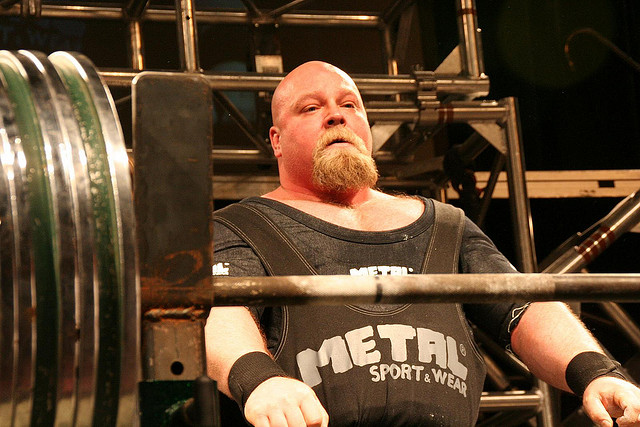
A lot of my tips are just repeats from everyone else but I think they get overlooked while everyone is looking for the next gear craze or shortcut. Some are gear related and some are raw work.
Simple things for a better bench:
1. Speed Day - Work your speed day religiously for the first 3-4 years of your powerlifting career. You must improve technical skill and force production by all muscle groups involved including the weaker ones. Timing really is everything.
2. Raw work - For the first 3-4 years we followed a Westside/EFS template on max effort work .You must do the raw max effort work to raise your capacity and base strength. This will help you avoid injury such as a pec tear and enable you to see weaker muscle groups more easily as you rotate from exercise to exercise. For example, inclines are mainly a shoulder movement. If you suck at these, but have a decent bench then you have discovered a weaker muscle group to work on. Raw work is good work.
3. Hold the weight - This is an easy way to develop more strength, stability and confidence with the big weights. You simply hold the bar for 2-3 extra seconds at the beginning of a press and then hold 2-3 seconds at the end before you rack the weight. This also cured our issues about racking the bar too quickly at meets and missing attempts plus it shows control which also makes the judges happy. Happy means white lights.
4. Leg Drive - This one is missed by most novices and even some big benchers. Scott Mendelson put it to me this way and I didn't realize it until he said it but leg drive can give you 200-400lbs on your bench. You must get your legs in the game and an easy way we found to do this is by pushing into the front of your shoes. In other words, feet flat and when you press, shove your toes into the front of the shoes. Push your body along the bench which will also maximize leg drive but will keep your tail on the bench. Remember, judges happy...
5. Do your board work - Whatever you can two-board in a shirt you should be able to do in a meet. Do 5 sets of 3 for several weeks before a meet. Keep going up until you can't get 3s then you back down. This will make the weight seem very light when you max out. Remember: Time under tension and confidence. You can also do raw two boards the same way in the same week. This worked well for us.
6. Fat Bars - Use fat bars, 1and 3/4 or 2 inch, as much as possible in training. These are easy tools that improve grip and interaction between muscle groups. You must squeeze the bar harder to control it which stimulates more muscle recruitment from all groups involved. The bar path is little different as well which makes it harder to use. The best part is that fat bars make the regular bench bars feel like toothpicks in your hands and you feel like you can press anything.
7. Learn your shirt - Each shirt is different. Some denims require you start the bar over your chest and touch on the belly or upper abdominals while a lot of polyester shirts start the bar in the upper chest region and throw the bar back towards the rack when pressing. Whoever you get it from, find out the shirts requirements for the best results. Use the shirt for at least 8 weeks prior to a meet to break it in and find your groove.
8. Lockout - We all know to tuck the elbows on the decent of the bar, but what about the lockout? I imagine it from two angles. One is squeezing only from the elbow when the lockout has slowed down too much. The other is trying to separate the lower bicep from the forearm as quickly as possible or another way to look at it is to imagine straightening the arm out while pressing. Sometimes this takes my mind off the weight just long enough to get the lift finished.
9. Use Bands - Use lots of band tension on speed day and heavy days. I like them doubled-up which provide maximum over speed eccentric load/stretch reflex or whatever you want to call it and lots of lockout work on both upper days. This is also a form of trickery for the CNS and brain where the load is deceiving and often it is much higher than you realize. This builds confidence and allows to body to utilize its full capacity which we never totally tap into but we can add a whole lot of pounds to the bench by doing so
10. Don't forget the small stuff - Kettlebells, GPP and auxiliary work; don't skip it. This is just as important as benching itself. I made this error over the past two years and paid for it. I lowered it to almost nothing and my weights shot up for awhile but then stopped. I was stuck. You need GPP for your wind and health. You have to have the ability to do the volume or you won't improve. This is GPP. You need auxiliary work to continue to raise and maintain all muscle groups involved in the bench. Lastly, get some kettlebells. For the average man, I would suggest getting sets of 25, 36, 53 and 72s. Kettlebell snatches, swings, presses, arm bars, etc. will thicken and develop your upper body. They will also improve your bench and GPP in the process. I think kettlebells by themselves will add 50lbs to anyone's bench and make the bodybuilders in your gym jealous of your giant traps, upper back and shoulders in the process.








